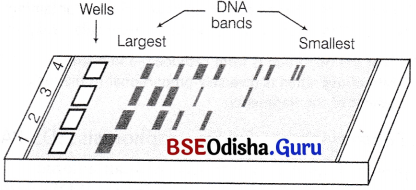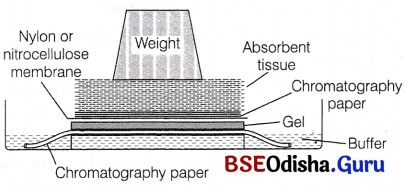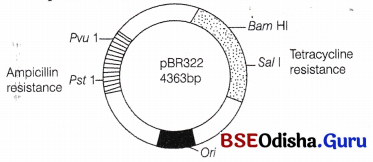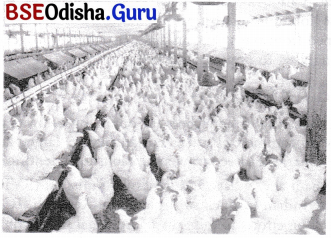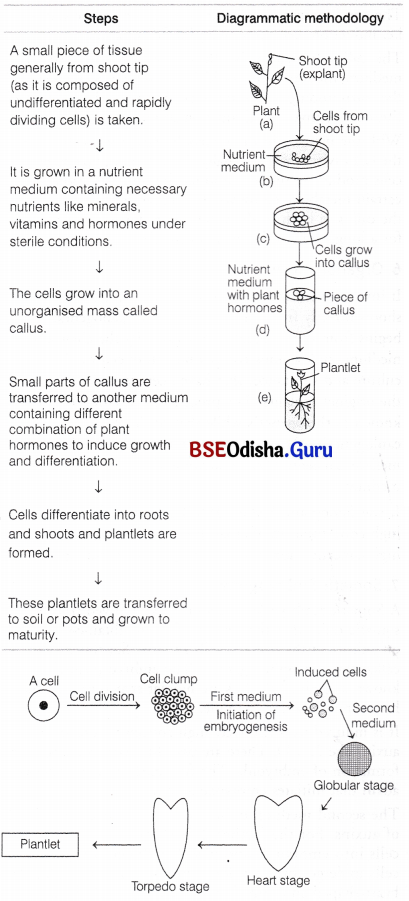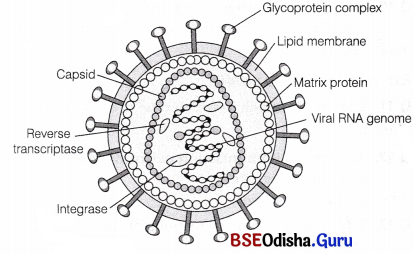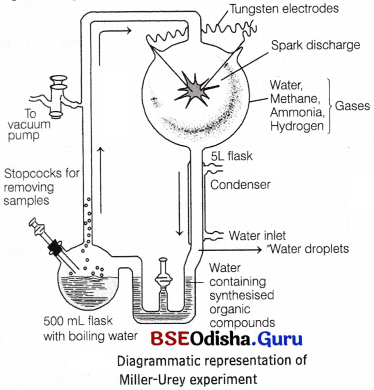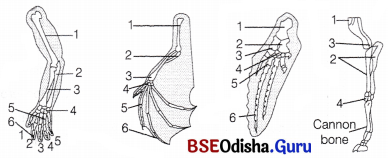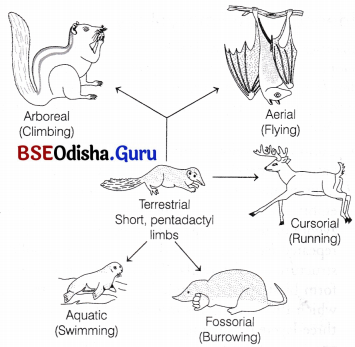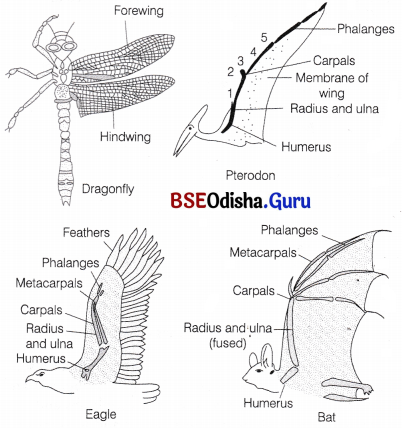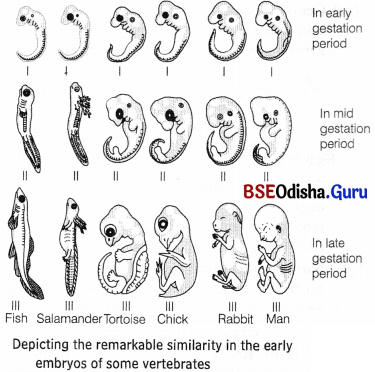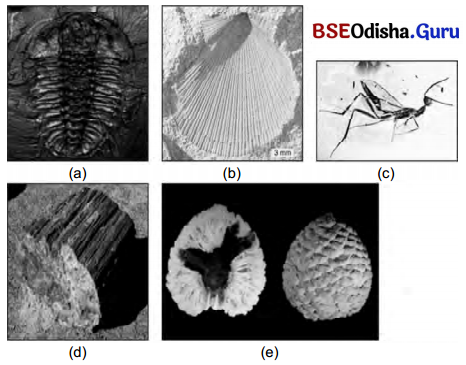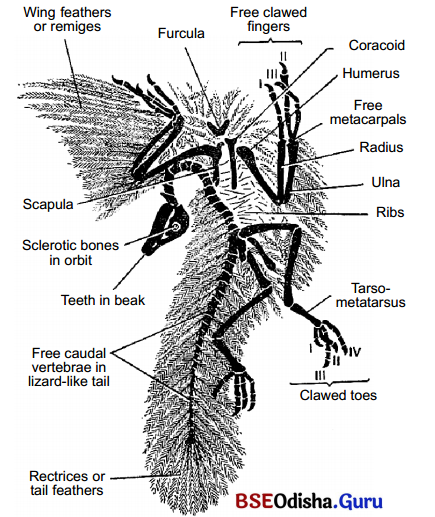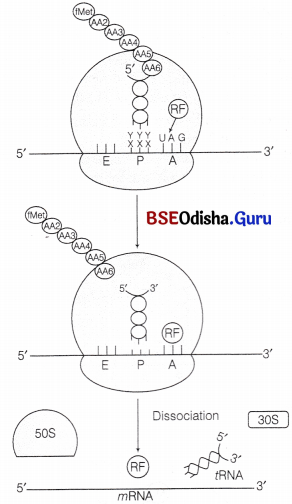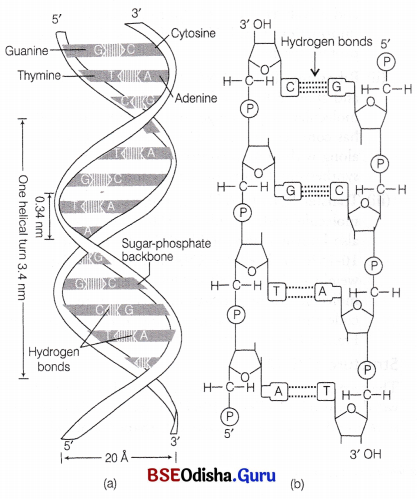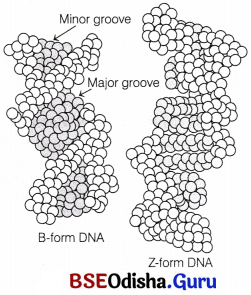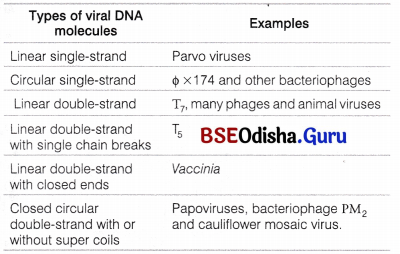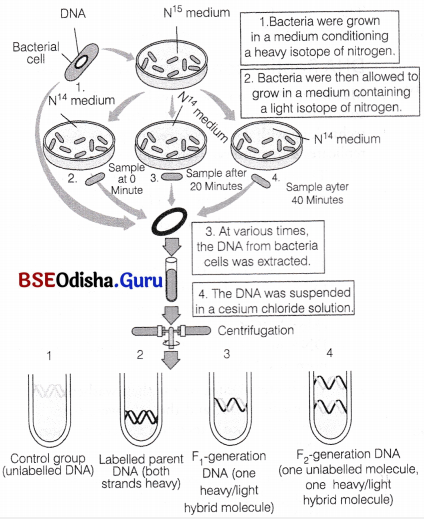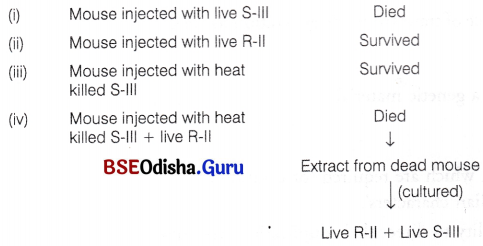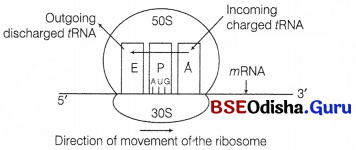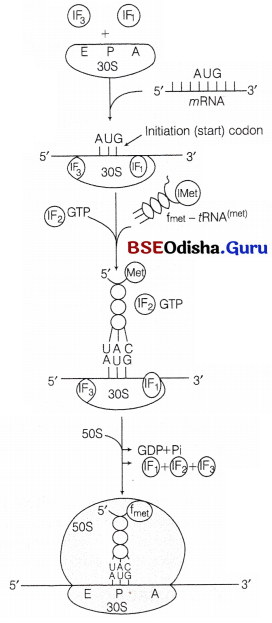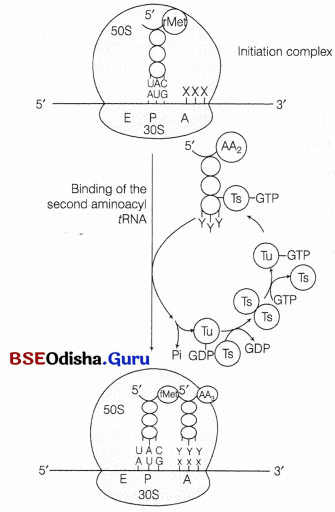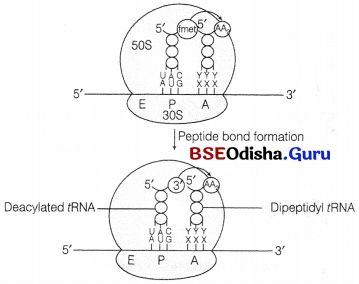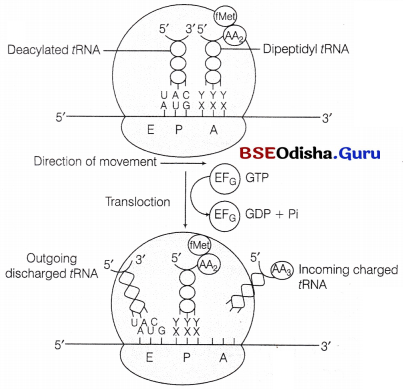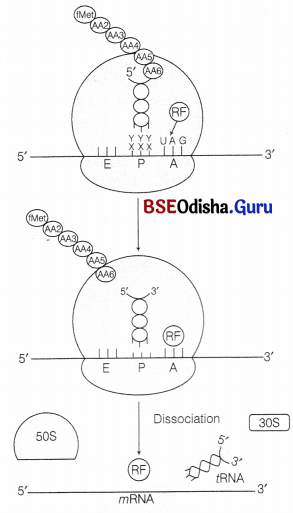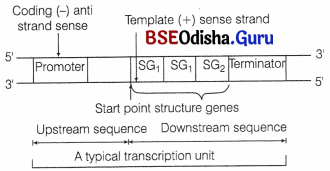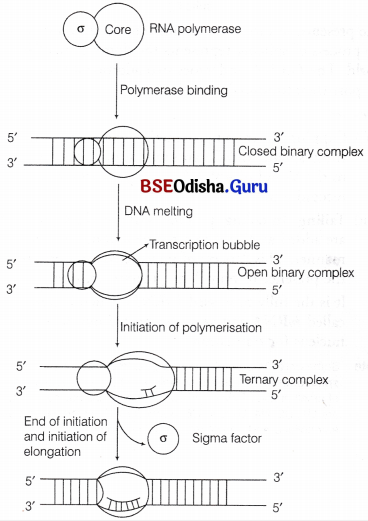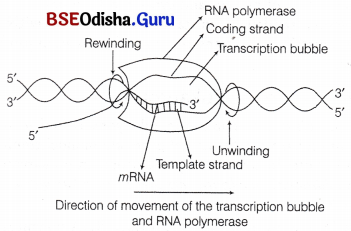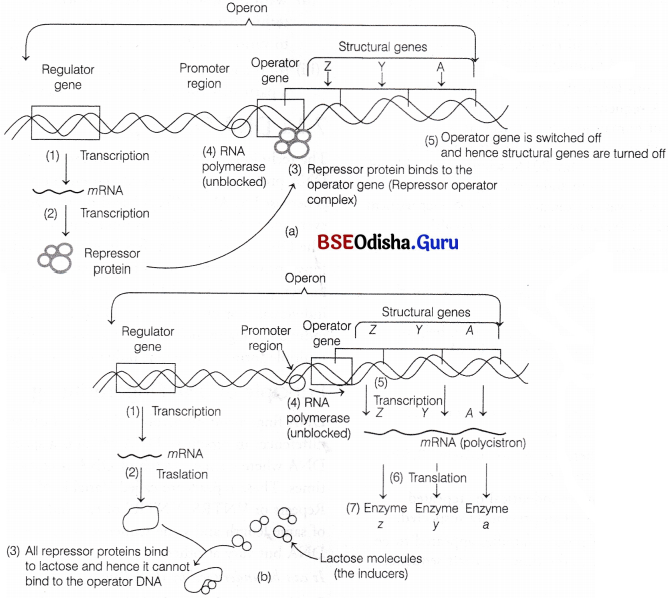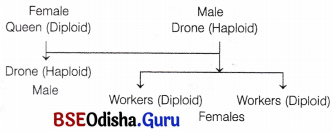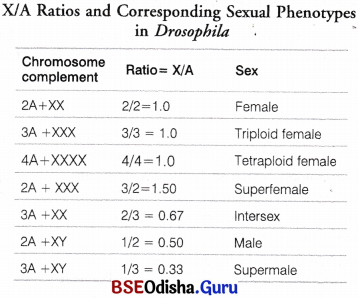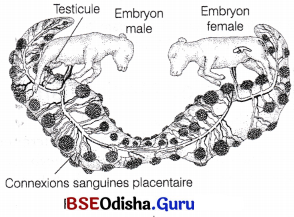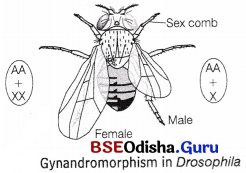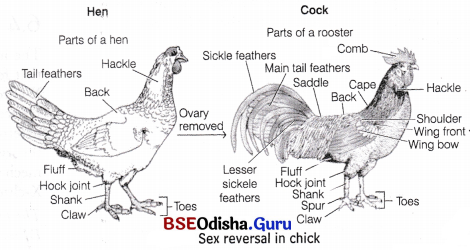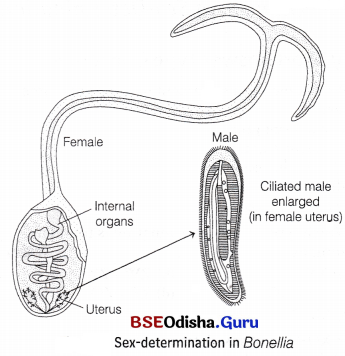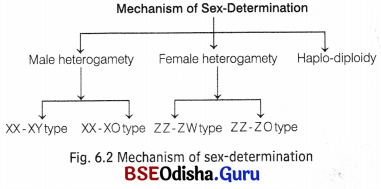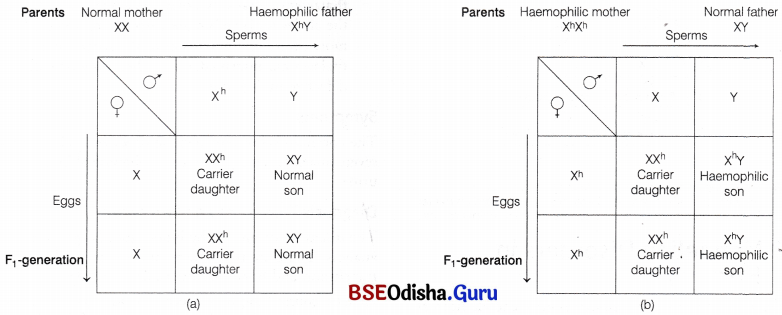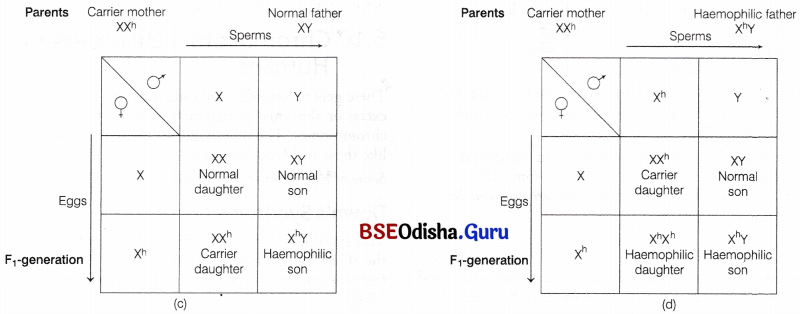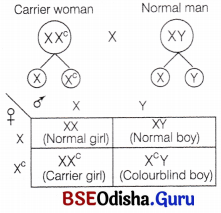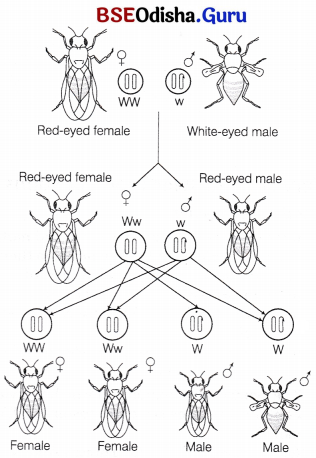Odisha State Board CHSE Odisha Class 12 Economics Solutions Chapter 12 Money and Banking Questions and Answers.
CHSE Odisha 12th Class Economics Chapter 12 Question Answer Money and Banking
Group – A
Short type Questions with Answers
I. Answer with in Two/Three sentence.
Question 1.
Money facilitates credit transaction.
Answer:
Money acts as standard of deferred payment & on account of this, anybody can postpone its payment for current transaction & pay it in future. It shows that money facilitates credit transaction.
Question 2.
Money is what money does.
Answer:
Money performs a wide variety of functions almost in all fields, money has got certain role to play. So it is rightly told money is what money does.
Question 3.
Bank drafts & cheques are near money.
Answer:
Bank drafts & cheques perform the functions of money; but these are not so liquid nor legal tender like money. So there are named as near money.
Question 4.
Every loan creates a deposit.
Answer:
When any person gets loan from a bank, the t^ank opens an account in the name of this borrower & frrom this account the borrower withdraws the money. So every loan creates a deposit.
Question 5.
Current deposit does not bear any interest.
Answer:
Current deposit is such a deposit which can be withdrawn at any date during the banking hours without having any restriction or early information. Because of such high frequency of withdrawal, the bank does not pay any interest.

Question 6.
Comercial banks are the agents of economic development.
Answer:
Commercial banks mobilises the saving of the individuals & invest money in productive channels. So commercial banks are called the agents of economic development.
Question 7.
Central bank is the lender of the last resort.
Answer:
When any commercial bank is under the crunch of financial bankruptcy, the central bank gives loan to the commercial bank for its revival. So it is called the lender of the last resort.
Question 8.
Central bank is the bankers’ bank.
Answer:
Central bank guides, advises & frames rules for the commercial banks. It also keeps a fraction of deposit of commercial banks with itself to meet the emergency & also determines the bank rate & controls the credit. So, it is called bankrs bank. .
Question 9.
Central bank is the bank of the government.
Answer:
Central bank guides, advises & suggests the government for its smooth functioning of economic system. It gives loan to the government & directly deal with the problem of the government. So, it is called as the bank of the government.
Question 10.
Central bank controls credit.
Answer:
When there is credit expansion made by the commercial banks, the central banks comes forward to control it through its monetary & fiscal operation alongwith certain selective’ credit control measures. The central bank thus, controls credit.

Question 11.
Central bank is the apex bank.
Answer:
In monetary affair, central bank plays a vital role in banking business. It controls, guides & advises the commercial banks. So it is called apex bank.
Question 12.
Money facilitates credit transaction.
Answer:
Money acts as a standard of deferred payment as well as a store of value. So it can facilitate credit transaction.
Question 13.
Near money is optional.
Answer:
Near money though performs certain functions of money; yet it lacks liquidity and legal approval in respect of universal acceptability. So it is optional.
Question 14.
Bank money is not legal tender.
Answer:
Bank money like draft and cheque do not have universal acceptability and also lack liquidity like money. So it is quite optional because of legal approval.

Question 15.
Commercial banks create credit.
Answer:
Commercial banks can give loan to the borrower which can be disburbed through opening an account. Thus commercial bank gets scope to create credit.
Question 16.
Central Bank is the bankers bank.
Answer:
Central bank guides advises and suggests the commercial banks with regard to monetary transactions. These banks keeps a fraction of their deposit with central bank to create credibility and reliability among the customers. So central bank is the bankers bank.
Question 17.
Central bank has the monopoly of note-issue.
Answer:
Central bank is the apex bank which controls the money supply in the economy. In order maintain uniformity in the money supply and to control economic hazards, the central bank enjoys the monopoly of note issue.
Question 18.
Central bank is the lender of the last report.
Answer:
Central bank gives loan to the commercial bank at the time of its need. When commercial banks becomes bankrupt, central banks comes forward to help these banks for their revival. So the central bank is called the lender of the last resort.
II. Answer with in Five/Six sentence :
Question 1.
Money acts as a standard of deferred payments. Explain.
Answer:
Money possesses the feature of ‘general acceptability’. Hence, it is quite natural that money facilitates the deferred payments. In other words, money, being the medium of exchange, facilitates the credit transaction through its function as a standard of deferred payments. But for this, money must maintain a constant value through time.
Question 2.
What is Near Money?
Answer:
Money consists of legal tender money and bank money. In case of big transactions where large payments are involved bank money in the form of bank drafts, bank cheques is used. In modem economies, bank money plays a vital role and forms a major proportion of money supply.
There are other assets which cannot be technically regarded as money but are claims to money and perform some functions of money. Such assets one called ‘ Near Money’. Near Money refers to all those assets which possess many of the features of money, have high degree of liquidity, and can be easily converted into maoney. Near money cannot be directly used for making transactions. This must be converted into money proper before use. Near money assets are highly liquid but is not as liquid as the money is. They are close substitutes of money but not the perfect substitutes. Some examples of near money are Bills of Exchange, Bonds, Debentures, shares etc.
Question 3.
Distinguish between Money and Near Money.
Answer:
The distinction between money and near money can be expressed on the following grounds.
(i) Definition – Money consists of coins, currencies and demand deposits of the banks whereas Near Money includes the financial assets like time deposits, bills of exchanges, bonds, equity shares etc.
(ii) Liquidity- Money is found to be highly liquid in comparison to Near Money.
(iii) Function – Money serves as a Unit of Account or a common measure of value. But Near Money does not perform such functions.
(iv) Transaction- Money can be spent directly for making any sorts of transaction but Near money lacks this; rather it should be converted into money proper before its use.
Question 4.
Show that Money and Near Money are similar.
Answer:
Both the Money and Near money are claims. Money proper like, coins and currency notes are claims over the government and Central Bank. Near money assets are claims over their respective parties or institutions. Secondly, liquidity is the common attribute of both money and near money. Lastly, both money and near money act as a store of value.

Question 5.
What is current deposit?
Answer:
Current deposit is that deposit which can be withdrawn in as many times and in as much amount as desired by the depositor. Normally no interest is paid on these deposits. Current deposits are otherwise called Demand Deposits and are very much popular among the businessmen and traders.
Question 6.
What is cash credit?
Answer:
Cash credit is a type of loan given to the borrower against his current assets such as shares, stocks, bonds etc. Such loans are not based on personal security. The bank opens an account in the name of the borrower and allows him to withdraw the sanctioned amount from time to time up to a certain limit as determined as the value of his current assets. Interest is charged only on the amount withdrawn.
Question 7.
What is overdraft?
Answer:
Overdraft is a system adopted by the Commercial Banks to advance loans to its depositors over and above their amount deposited. Under this facility, the customers of the bank are allowed to withdraw more amount than their deposits. Interest is charged from the customers on the overdrawn amount.
Question 8.
Commercial Banks create credit. Explain.
Answer:
Credit creation is a unique function of the commercial banks. Credit creation is the natural outcome of the process of advancing loans as adopted by the banks. When a bank advances a loan to its customers, it does not lend cash but opens an account in his name, and credits the amount of loan to this account. Thus, whenever a bank grants a loan, it creates an equal amount of bank deposit creation and such deposit is called credit creation which results in a net increase in the money stock of the economy.
Banks have the ability to create credit many times more than their deposits.
Question 9.
Write a short note on “Lender of the Last Resort”
Answer:
As an apex bank and banker’s bank, the Central Bank acts as the lender of the last resort. Whenever, the commercial banks are not able to meet their financial requirements from any other source, they approach the Central Bank for financial accommodation. The Central Bank provides such financial accommodation to the Commercial Banks by rediscounting their eligible securities and exchange bills. Thus, the Central Bank is considered to be the ‘Lender of the Last Resort”

Question 10.
Write a short note on “Banker’s Bank”.
Answer:
The Central Bank acts as the ‘Bankers’ Bank” in three capacities such as (a) a custodian of the cash reserves of the Commercial Banks, (b) the Lender of the Last Resort and (c) as clearing agent. As a custodian of the cash reserves, the Central Bank maintains the cash reserves of the Commercial Banks. Every Commercial Bank has to keep a certain percentage of its cash balances as deposits with the Central Bank. Thgse cash reserves are utilised at the time of urgency raised by the Commercial Banks. Since all the banks have their accounts with the Central Bank, the Central Bank can easily settle the claims of the commercial basis. Hence, the Central Bank acts both as the lender of the last resort and as a clearing agent for the Commercial Banks.
Question 11.
Write a short note on “Cash credit”.
Answer:
Cash credit is tfie credit granted against the borrower’s promissory notes guaranteed by at least two securities. Sometimes it is supported by a pledge of securities or goods. In such cases, if advances are sanctioned, the bank opens an account in the name of the borrower & the loan amount is credited to this account. The borrower pays the interest on the amount already withdrawn. This is very popular amongst the business man.
Question 12.
Write a short note on “Fixed deposit”.
Answer:
The deposits which are made for fixed period of time are called fixed deposits. There deposits can not be with drawn before the expiry of the period. The bank utilises these deposits in profitable channels & also pays higher rate of interest. These deposits are other wise called time deposits.
Group – B
Long Type Questions With Answers
Question 1.
What are the functions of money?
Answer:
Economic activities have become complex and aggravated the difficulties of barter. Barter has become unsuitable under the modems economic condition. So the device of money has been adopted to over come the drawbacks of the barter system. The following are the functions of money:
(i) A Medium of Exchange : The most important function of money is that it serves as a medium of exchange. Now a weaver does not directly exchange his cloth for com. He exchanges it for money. Then he converts his money into com. So if the weaver wants com, her first converts his cloth into money and then money into com. Money comes in between the exchange of the two commodities and act as a medium of exchange. Thus, it eliminates the greatest disadvantage of barter namely, the necessity of double coincidence of wants. This function of money is of greatest economic value. Now-a-days, the wheels of commerce move quickly because there is money which acts as medium of exchange.
(ii) Measure of Value : The value of commodities can be accurately expressed in terms of money. Money works as a common denominator and the values of all commodities can be compared. This facilitates exchnages – Just as we measure the cloth with a yard stick, we measure the values of commodities with money. This function of money removes another disadvantge of barter system namely, the difficulty of measuring the value of commodities. We can keep accounts and enter into contracts in terms of money. Hence money is also called standard of account.
(iii) Standard of Deferred Payments : Borrowing and lending are the important features of modem economy. Commodities and services are taken in advance and payments are made later on. Many transactions are done by means of credit. This is made possible because there is money economy. Without money, we cannot imagine borrowing and lending. Debts and interest on debts can be accurately calculated in terms of money. Uniform price (money interest) for a uniform service (money lending) is made possible by money. Comparatively great stability in value of money aids this function.
(iv) Store of value : Most of the commodities or service can not be store for long. They perish in course of time and lose their value. For e^mple, a labour can not store his labour. He can not make any provisions for old age or period of sickness, if there is no money economy. Now he can convert labour into money and store his money for any length of time. Money doesn’t easily perish and its value does not violently change. Money can also be kept as a liquid asset since it is useful for making ready payments.
There will mot be any incentive for savings and investments it there is no device of money as store of value, Money functions as a standard of store becuase it has got the quality of standard of deferred payments. These last two functions Jof money are interdependent. Without money we cannot imagine manufacture* employing thousands of workers in manufacturing automobiles or building ships. Payments are made to workers in money. Raw materials are purchased with money and the final product is sold for money. There are four functions of money. “All these so called functions money are simply different, but related aspects of the fact that the use of money is essential to a community based on division of labour and exchange.” (Benham)

Question 2.
What are the functions of commercial bank?
Or
Explain the services of a commercial bank.
Answer:
Commerical bank perform a number of services. Their services can be broadly classified under two heads,
(i) Primary services
(ii) Subsidiary and miscellaneous services.
Primary Services of a Commercial Bank: Banks do not borrow funds in the normal way. They adopt different types of technique. They borrow funds by accepting deposits.
These deposits are of three types. They are fixed deposits, current account deposits and savings bank deposits. Under fixed deposit system, the depositor agrees to keep his money with the bank for as agreed period. He is not allowed to withdraw the money before the expiry of the period. He gets interest on the money for the period. Rich people keep their money with the banks under fixed deposit accounts.
Under current account system, the depositor is allowed to withdraw money upto the deposit amount at any time during the banking hours. Traders and businessmen keep their money with banks under current accounts. All the depositors don’t withdraw their money at the same time. So a banker can use a large part of the money or current accounts for profitable purpose.
Savings bank deposits are intended to make small income groups save something out of their monthly incomes. Banks accept even small amounts under savings deposits. The customers are allowed to withdraw money. But restrictions are placed on such withdrawals.
The banks receive large volume of funds through these deposit accounts from a wide range of people. They pool together the small and scattered amounts of money from large number of people and make them available as loans to trade and industry. Such scattered amounts would remain idle but for banks. Thus banks render three heads. They are overdrafts, cash credits and direct loans.
Overdrafts : Sometimes a customer is allowed to withdraw more than what he has deposited. In this case the bank is said to allow overdraft. The bank charges interest on the amount which is overdrawn by the customer.
Cash Credits : The loan amount is not directly handed over to the customer. A current account is opened in his name and the loan is placed to the credit of his account. The customer can withdraw this amount by cheques according to his need. Interest is calculated not on the total amount of the loan, but oh the amount which is actually utilised by the customer. However, the bank collects some minimum interest wheather the customer makes use of the funds at his disposal or not. Traders prefer cash credits to ordinary loans. Banks also prefer cash credits because they need not pay the entire amount of the loan on the same day. The customer is asked to withdraw the amount by cheques gradually. On the whole, cash credits are very popular in India.
Ordinary Loans : the borrower lodges some securities with the bank and takes the loan amount. The borrower has to pay interest on the entire amount from the date of taking the loan to the date of repayment. Banks also provide lonas to the customers by discouting bills of exchange.
Subsidiary Services of the bankers:
Demand drafts : Banks issue drafts and facilitate remittance of funds from one place to another. When large sums of money have to be sent from one place to another. It is not economical to send them by money order. The best way is to employ the bank as the agent of remittance by purchasing demand draft. The bank collects charges for issuing drafts.
Collection of cheques, bills, pay orders etc of customers : Commercial banks undertake to pay subscriptions insurance premium, rents etc. on behalf of their customers on their standing orders. They make such payment and debit the accounts of their customers. Similarly, banks collect subscriptions, insurance premium or rent etc. on behalf of their customers and credit their accounts. Trustees, executors and attorneys etc: Banks undertake to act as trustees, executors and attorneys on behalf of their customers, if they are authorised to do so.
Purchasing ans selling Securities : Banks also undertake to purchase or sell securities on behalf of their customer. They advice their customers in the matfers of investment.
Issue of letters of credit, circular letters, traveller’s cheques etc : Banks issue letters of credit to the customers and facilitate trade connections with foreign countries. Circular letters are issued to tourists. It is not safe to carry money in person. When a circular letter is taken from a bank, the customer can get cash from banks situated at different places. The issuing bank makes previous arrangements with different banks at different places.
Safe custody deposits : Commercial banks receive valuables such as jewels etc. for safe custody. The banks maintain strong valuts for this purpose. They charges small fee for this services.
Trade references : When a trader wants to establish business connections with a new client be seeks information regarding financial standing and business reputation of his new client. Banks provide such information regarding the business reputation and the standing of their customers on thier request.

Question 3.
Explain the various types of deposits of a commercial bank.
Answer:
The most important function of a commercial bank is to borrow funds from the people and lend them to the people who are in need of them. Bnaks do not borrow funds from the public in the ordinary way They borrow funds through deposits. Bnaks make attempts to attract funds from a wide range of people. They offer different terms to different classes of people for attracting deposits.
The banker’s deposits may be classified under four heads depending on such terms. They are (a) fixed deposits (b) current account deposits (c) savings bank deposits and (d) seasonal deposits.
Fixed Deposits : Under this system, the customers agree to keep their funds with the bankers for a definite period say 1 month, 3 month, 6 month etc. They are not allowed to withdraw this amount within this stipulated period. These funds are at the disposal of the bank till the end of the agreed period. The banker can utillise them for profitable purposes. These deposits are also called time deposits. Some banks allow their customers to with draw these deposits after giving a week’s notice, or fifteen days notice. Banks give interest to the customers on the fixed deposit amounts. People who have surplus funds and who are not able to invest their funds otherwise, keep their money in fixed deposit accounts with a bank. Banks receive large volumes of funds on fixed deposits accounts.
Current account deposits : Under this system, the depositors are allowed to withdraw their money at any time during banking hours. There are traders, manufacturers and other people having large volume of funds. But they can not afford to lock up thier funds in fixed deposit accounts. They require money constantly for business purpose. Banks attract funds from such types of people through current account deposits, The depositor is given a cheque book. He can withdraw money any number of times through cheques.
He is also given a pass book in which all transactions between him and the banker are recorded. Traders generally keep their money in current account deposits and make their payment through cheques. Banks receive large volume of funds under this head. Though customer have a right to withdraw money from their accounts, the banker know by experience that all the customers do not withdraw on the same day. Some customers will be withdrawing and some will be depositing. When a customer pays another customer by cheque, the business of the banker is to transfer the amount of the cheque from the account of one person to that of the other. Such transfer of transactions are called transfer transactions. Such transfer transactions will be more common than actual cash transactions.
On the whole, a banker finds it possible to invest a greater portion of the funds received on current accounts for profitable purposes.
Savings bank deposits: Under this system, people with small incomes are encourged to save what all they can. Deposits of even small amounts are accepted. The depositors are allowed to withdraw money from their accounts. But the bank imposes some restrictions on their withdraw is Banks in India do not allow their customer of this class to withdraw more than twice in a week. Further they are not allowed to withdraw more than 2000 rupees in any week, unless a special notice to that effect is given.
Savings bank account faculties encourage thrift among public especially people with small incomes. Banks give intrest of 214 to 3 percent on the monthly minimum balance maintained by the customers. Commercial banks get a very large volume of funds under this head. Owing to restrictions on withdrawas they can utilize a large part of these funds for profitable purposes.
Seasonal deposits: In the agricultural countries there will be heavy demand for loans during a particular season. To meet the demand for loans, commercial banks attract deposits by special inducements in the shape of higher interest during that season. These deposits resemble fixed deposits. They are accepted for a particular period. Withdrawl are not allowed before the stipulated period. But these deposits are not allowed to stand after the season.
Briaks also attract funds by selling cash certificate. Thus Banks attract funds by way of deposits and render a very useful services to the society. But for the banks such funds would have remained scattered with the people. Banks pool such scattered funds and make them available to industry and trade.
Question 4.
Explain how banks create credit? What are the limits to the powers of the banker in creating credit?
Answer:
A Banker is said to create credit when he credits the deposit accounts of his customer on aquiring assets other than cash, such as over drafts, cash credits bills and stocks. The bank clerk simply credits the deposit accounts of the customer who take loans under overdrafts or cash credit arrangement. The credit balance with a banker is as good as money. So it is said that banks create credit is the creation of bank clerk’s pen.
A banker acquires profitable assets in the process of creation of credit. But he can not go on acquiring such assets in exchange for his credit entries. There are certain factors which limit the capacity of a banker in creating credit. Following are Such factors :
(a) Supply of legal-tender money : Credit transactions do not end by themselves. They resolve into cash transactions at one time on the other. So the banker must maintain adequate cash reserves to meet the demand obligations of his customers. The banker knows by experience, the minimum percentage of cash to deposits, which he has to maintain to meet the withdrawals of his customers. Failure to maintain this safety minimum will land the banker in troubles – For example, a banker can create credit up to ten times the cash reserve if the conventional and needed percentage of cash to deposits is ten.
So credit depends on the available supply of cash in the values o the bank. The cash reserves of the commercial banks depend on the total supply of money in circulation and its velocity. The central bank is the institution which controls the volume money and its velocity circulation. The commercial banks have no control over the legal tender money. So they have to adjust the volume of their credit to the available supply of the legal tender money which they acquire in the ordinary course of banking through share capital.
(b) Popularity of cheque currency : In countries where cheques are popular, cash withdrawals will be less. There will be more transfer transactions. So the banker can manage the business with a low percentage of cash to deposits. This enables the banker to create credit extensively. On the other hand, in a country where cheque system is not popular, more cheques will be presented at the counter for encashment. The banker must maintain a high percentage of cash to deposit. This reduces the capacity of a banker to create credit.
(c) Statutory reserve ratios : Commercial banks have to maintain some minimum percentage of cash to deposit in their accounts with the central banks. This is a statutory obligation imposed on commercial banks in several countries. The central bank can impose penalty on banks which fail to maintain the statutory mimimum. Central banks have discretion to vary the reserve ratio alos. Banks have to adjust their-deposit liabilities in conformity with the statutory ratio.
(d) Trade activity : During the periods of rising prices, the trade conditions appear rosy and traders borrow loans on a large scale to finance their trade activities. So there will be increased demand for bank credit and banks expand credit.
(e) Policy of the Central Bank: CentraTbank is armed with weapons to control the credit created by the commercial banks. Bank credit constitutes purchasing power. When banks expand credit discriminately in the prices tend to rise and the symptoms of inflation appear. The central bank is charged with the function of correcting such a situation The central bank employs its conventional weapons such as bank rate or open market operations etc and tries to control the activities of the commercial banks in creating credit. Commercial banks ultimately have to fall in line with the credit policy of the central bank.
(f) Liquidity Preference of the People : The capacity of commercial banks to create credit also depends on the degree of preference of the people to hold liquid cash. The degree of liquidity preference is influenced by certain economic and speculative considerations. Banks have to adjust their credit in accordance with the liquidity preference of the people.
So the supply of cash in the vaults of a commercial bank is influenced by the above factors and the banker has to adjust his deposit liabilities in accordance with the volume of cash reserves.
Do banks Create Credit ? : The banker creates credit when he grants a loan to a customer under overdraft or cash credit arrangement. The loan amount is not given to the customer in the shape of cash immediately. The loan amount is placed to the credit of the customer and the customer is asked to withdraw the amount through cheques whenever he needs the money. Similarly the banker creates credit when he purchases a bill or a stock from a customer and places the amount to the credit of the customer.
The customer is satisfied with the credit entry in his favour. He does not insist on immediate cash payment. So the banker is able to create credit because the customer is willing to keep the money with the banker. This willingness of the customer to retain the cash with the banker. This willingness of the customer to retain the cash with the bank enables the banker to create credit.
Certain writers like Walter leaf and Cannan say that the initiative in the creation of credit does not lne with the banker. It lies with the customer who is willing to retain the money with the banker. Hartley withers on the otherhand, says that the initiative in the creation of credit lies with the banker as “loans make deposits”. When a banker advances a loan he is crediting the deposit account of the customer. Hence loans in one shape or the other increase the deposit liabilities.
But it is true that if the customer demand cash immediately, there will not be an increase in the deposits. But in the countries where banking habit is well developed, payment are usally made through cheques. Borrowers prefer to keep the amount of loan with the banker and issue cheques against it.
If the payee of the cheque also happens to be the customer of the same bank, his deposit will increase to the extent of his cheque amount and the account of the drawer will decrease to that extent. Hence the total deposit liabilities will continue to be at the same figure, so long as the loan remains. If the payee happens to be the customer of another bank, the deposit liabilities of the second bank will rise. In either case, the increase in the deposit is the result of the loan.
But according to Walter Leaf and cannan, the initiative in the creation of credit does not lie with the banker. The banker is able to lend money because the depositors are not withdrawing cash from their accounts. So the banker is only lending what others have left with him. Leaf compares the transactions of a bank with a cloakroom. Suppose there are 100 guests to an evening party. Each of them has brought a cloak which is deposited with cloakroom attendent. Suppose the cloakroom attendend knows that the party does not break up before 10 p.m. The attendent can loam out a greater portion of the cloaks, say 80 cloaks on the conditiob that they should be returned by 9-30 p.m. If by chance any guest departs before 10 p.m. he can give one of the cloaks that arejceept in reserve.
In this case, we can not say that the cloak room attendent has created 80 cloaks. He has’ simply loaned out the cloaks that are kept with him. Similarly, we cannot say that the banker is creating deposits. He is only lending the funds that are deposited with him by some customers.
It is true that the willingness of the customers to keep their deposits with the banker is helping him to create credit. A customer keeps the money with the banker, because he has confidence in the banker’s ability to repay the amount, when he demands it. The banker is infusing confidence into the customer. Hence, we may say that the banker is creating credit.

Question 5.
What are the functions of a central bank?
Answer:
A central bank is the most important institution of money market. There will be one central bank for each country. The International Monetary Conference held in Brussels in 1920 recommended the establishment of a central bank in each country where there was none. A central bank is usally owhed and managed by the government. Even if is owned by private individuals, the government takes an active part in its management.
A central bank has distinct functions of its own. Generally it is not allowed to perform the functions of a commercial bank Or compete with commercial banks. The functions of a central bank are very vital to the economy of a country. It is given monopoly in the discharge of its functions. The functions of a central bank are given below.
(i) Note Issue : Issuing of notes is one of the most important functions of a central bank. It is usally given monopoly in issuing notes. A central bank as a note issuing authority is expected to maintain stability in the value of currency. There are different methods of issuing notes such as fixed fiduciary system, maximum fiduciary system, proportional reserve system, variation of the proportional reserve system and minimum reserve system.
A central bank may adopt any one of these systems depending upon the economic conditions of the counrty. A central bank issues notes consistent with the principles of safety and elasticity. Usally, the government lays down the principle of note-issue. Some countries prescribe a gold clause against note-issue. Then the central bank has to maintain the prescribed ratio of gold to notes. Whatever be the principle, it is the duty of central bank to maintain the internal and external value of its currency.
(ii) Banker to the Government: A central bank acts as a banker to the government. It maintains the accounts of the government. It enjoys monopoly in this respect. It receives the revenues and makes disbursements on behalf of the government. It maintains public debt registers, it helps the government in raising loans, in making interest payments and in redemption of loans It also grants short period loans to the government. It acts as a financial advisor and foreign exchanges.
(iii) Banker to the Commercial banks : Acentral bank is regarded as a philosopher, a guide and an advisor to other commercial banks. Commercial banks maintain accounts with the central bank either by tradition or by statutory obligation. Commercial banks consider it a matter of prestige to come into contact wih the central bank. The central bank looks into the affairs of the commercial banks and raises the general standard of banking. It offers remittance facilities to the commercial banks.
A central bank manages the clearing house. A clearing house is a place where banks settle their indebtedness arising out of inter-book transactions. The central bank provides clearance facilities by managing of the clearing house. Clearance facilities enable the commercial banks to economise the cash reserves.
Central banks acts as a lender of the last resort. It lends funds to the (pnmercial banks and helps them to tide over the difficulties. It advances loans against eligible securities or rediscounts first class bills of the commercial banks. The functions of the central bank increases the structural stability of the banking system. It also increases the liquidity of some of the bankers assets.
Central bank acts as a custodians of the national reserves. A single reserve in the hands of the central bank is not only economical but also very effective in meeting emergencies. All commercial banks have to maintain some balances in their accounts with the commercial bank. The government also maintains a minumum balance in its account with the central bank. All these funds constitute national reserves. Besides the central bank has to maintain a minimum gold reserve under statutes and also foreign currencies. These can be effectively employed to meet any national emergency.
(iv) Controlling of credit: This is another important function of a central bank. A central bank has to regulate the credit created by commercial banks. Commercial banks sometimes create credit indiscriminately in their anxiety to get more profits or to avoid losses. Such indiscriminate expansion or contraction of credit is affects price level, empolyment, foreign trade etc. So it is the duty of the central bank to regulate credit and maintain stability in the value of currency and other economic conditions. The central bank has several weapon to control credit. They are (1) the bank rate (2) open market operations (3) variation of the reserve ratios (4) rationing of the credit. (5) direct action and moral suasion.
Bank rate is the official minimum rate at which the central bank undertakes to rediscount first class bills or advance loans against eligible securities to the commercial banks. When the central bank thinks that the commercial banks are expanding credit unduly. It raises the bank rate. Commercial bank also raise their own rate of interest since the central bank is the lender of last resort. The borrowers find that the bank loans have become costly. So they reduce their borrowings from the bank. That is how credit is controlled through bank rate policy. Sometimes bank rate policy doesn’t work successfully especially when there are large volume of idle funds with the commercial banks. Then the central bank employs open market operations.
Open market operations consist of selling or buying eligible securities in the open market. The central bank withdraws money from circulation or puts more money into circulation by open market operations. When the central bank wants to curtail the bank credit, it sells securities. The investors make payments to the central bank by drawing from their deposit accounts. Thus, the central bank withdraws money from circulation. The banks find that their cash reserve have fallen. So they reduce their lendings. Similarly when the central bank wants to expand credit, it buys securities and releases more money into circulation. The money goes to the commercial banks by way of deposits. They increase their lendings as their cash reserves.
When the money market is not well organised, bank rate policy and open market operations do not work successfully.. Then the central bank employs another weapon called, the variation of the reservation. All commercial banks have to maintain on their accounts with the central bank, cash balance equal to a certain minimum percentage of their deposit liabilities. The percentage is called reservation. When the Central bank wants to control the credit changes the reserve ratio, it compels the commercial banks to maintain a higher percentage of cash balance in their accounts. The commercial banks have to remit cash to maintain the required percentage of balance. Their cash o n hand windless. So they have to reduce their lending. This is a drastic weapon in the hands of central bank to control credit.
The central banks also controls credit by the rationing of credit. The central bank fixed the quota for each commercial bank and gives accommodation only up to the quota fixed. The commercial banks adjust their loans to the traders on the basis of this quota. Sometimes the central bank may reject to rediscount certain class of trade bills. This also affect the pattern of lending of the commercial banks. This type of credit control is rarely effective and has to be used in exceptional circumstances.
A central bank can also control credit by moral persuasion. It sends directives to the commercial banks requesting them to control credit in the interest of the nation. This proves to be an effective method of credit control, if the commercial banks comply with the request of the central bank. This depends upon the prestige and the strength of central bank. If the commercial banks fail to comply with such request then the central bank may resort to direct action to control credit. Direct action involves a threat. But threats are unpopular in controlling credit.
Thus a central bank is armed with several weapons to control the credit and it is the responsibility of the central bank to regulate the credit in the best interest of the country. It safeguards the foreign trade through its credit policies. In addition to the above functions, some centra banks are charged with special functions. A central bank may be specially charged with the function of maintaining the external value of the currency. The Bank of England is asked to maintain a separ and fund called Exchange Equilisation Fund for the purpose.
The Reserve Bank of India is charged with the function of developing rural credit. It is asked to maintain a statutory department called “Agricultural credit Department” to find out ways and means to develop rural credit and to co-ordinate the activities of the various institution that supply rural credit.
Central banks are also expected to lend support to the governments in all nation-building activities and in implementing various economic plAnswer: Thus, the central bank is a very important institution and is very vital to the economic well being as a nation.

Question 6.
Explains the functions of a central bank as
(a) banker to the government and
(b) banker to other banks.
Answer:
(a) Banker to the Government: One of the important function of a central bank is to act as a banker to the government. The government is the lagest dealer in the currency and in foreign exchanges. So if the central bank is to maintain internal and exteranl stability in the value of currency, it must maintain the funds of the government. It is also convenient and economical to the state to entrust the management of its funds to the central bank. In some countries, the monopoly of government funds is enjoyed by the central bank as a matter of tradition. In most countries the relation between the state and bank is governed by the statutes.The government receives large revenues and spends huge amounts of money. Unless the central bank acts as a banker to the state, it cann’t adjust the supply of money to its demand and it can not fulfil some of its other functions successfully.
As a banker to the government, the central bank maintain account of various government such as the central government, state government local government etc. It receives revenues on behalf of the governments, and makes disbursements on behalf of the government, ft helps the government in raising loans. It managed the public debts and maintains transfer registers in respect of government stock and certificates. It helps the government interest payments on the loans and in the redemption of loans. It provides the government with foreign exchanges. It grants temporary loans to the governments. The receipts of the government are seasonal. But the expenditure of the government is spread out evenly throughout the year. The central bank helps the government in the adjustment of the revenue to the expenditure by granting short period loans.
Sometimes the bank also helps the government in raising short-term loans by re-discounting treasury bills directly or indirectly, when they are presented through the commercial banks. This is the easiest way for a government to raise short period loans. It manages exchange – clearances and collect statistics of various kinds of financial matters and makes them available to the government. It maintain considerable metallic reserves to meet contingencies.
It co-operates with the government in all the nation-building activities. It also help the government in the promotion of certain special interest which are necessary for the welfare of the country such as development of agricultural credit etc. as in India. It maintains research departments to study various financial problems that confront the government and it acts as a financial advisor to the government.
(b) Banker to the other banks : Commercial banks and other members of the money market maintain accounts with the central bank either by tradition or by statute. They have to maintain a certain minimum percentage of their liabilities in their accounts with the central bank.
A commercial bank derives the following advantages by maintaining an acount withe the cental bank:
- A central bank is the most important institution in the money market. It is regarded as a mother institution by the commercial banks. It is the banker to the government. So a commercial bank regards it as a matter of prestige to come into contact with the central bank.
- A bank must satisfy some conditions laid down by a central bank to become its customer.
- A commercial bank that maintains accounts with the central bank gains the confidence of the public.
- The central bank managing the clearing house. Generally a commercial bank that has an account with the central bank is eligible to become member of a clearing house. It can settle the inner bank and thus economise the use of cash reserves.
- The central bank also helps the commercial banks in the matter pf remittance of funds free of cost or at an exceptionally low rate of commission.
- A Commercial bank can secure loans from the central bank in times of need.
A central bank gets the following advantages by accepting accounts from the commercial banks :
- It can watch the activities of the commercial banks through their accounts.
- It can raise the general standard of banking by giving advices to its members.
- It gets large volume of cash reserves from the deposits of the commercial banks. It can employ these funds in assisting the commercial banks it times of crisis.
- A central bank can study the position of commercial banks at the clearing house. It can give a timely warning to a bank that faces adverse clearance continuously.
- A central bank can control the credit of the commercial banks through their accounts. The commercial banks have to maintain certain minimum cash balances in their accounts with the Central bank. By verifying this minimum, the central bank exercises control over the credit of the commercial banks.
The member banks have to submit periodical returns to the central bank. They enable the central bank to collect satistics of various types on banking activities. It can study the general level of banking and give advice to the members. The central bank is regarded by the commercial banks as a guide, friend and philosopher.
Question 7.
Difference between Central Bank and Commercial Banks.
Answer:
There are certain basic differences between a Central Bank and Commercial Banks. They are:
- The Central Bank is the apex monetary institution which has been specially empowered to exercise control over the banking system of the country. The Commercial Banks on the contrary is a constituent unit of the banking system.
- The Central Bank does not operate with a profit motive. The primary aim of the Central Bank is to achieve the objectives of the economic policy of the Government and maximise the public welfare through monetary measures.
- The Central Bank is generally a State-owned institution, while the Commercial Banks are normally privately owned institutions.
- The Central Bank does not deal directly with the public. The Commercial Banks, on the
contrary, directly deal with the public.
- The Central Bank does not compete with the Commercial Banks. Rather it helps them by acting as the lender of the last resort.
- The Central Bank is the custodian of the foreign exchange reserves of the country. The Commercial Banks are only the dealers in foreign exchange.
- The Central Bank has the monopoly of note-issue whereas the Commercial Banks don’t enjoy such right.
- The Central Bank acts as the banker to the Government, the Commercial Banks act as bankers to the general public.
- The Central Bank acts as the bankers’ bank :
- the Commercial Banks are required to keep a certain proportion of their reserve with Central Bank,
- the Central Bank helps them at the time of emergency,
- the Central Bank acts as the clearing house for the Commercial Banks. But the Commercial Banks perform to such functions.
Group – C
Objective type Questions with Answers
I. Multiple Choice Questions with Answers :
Question 1.
Which is not treated as function of money?
(i) medium of exchange
(ii) measure of value
(iii) store of value
(iv) all of the above
Answer:
(iv) all of the above
Question 2.
Which is not treated as near money?
(i) cheques
(ii) drafts
(iii) one rupee coin
(iv) bonds
Answer:
(iii) one rupee cQin
Question 3.
Bank drafts are called near money because
(i) it is easily convertible into money
(ii) it has got general acceptability
(iii) it has legal approval
(iv) all of the above
Answer:
(i) it is easily convertible into money
Question 4. Which deposit bears highest rate of interest?
(i) current deposit
(ii) fixed deposit
(iii) saving deposit
(iv) all of the above
Answer:
(ii) fixed deposit

Question 5.
What type of deposit is appreciated by the business man?
(i) fixed deposit
(ii) saving deposit
(iii) deposit made with bonds & securities
(iv) None of these
Answer:
(iii) deposit made with bonds & securities
Question 6.
Which deposit can be withdrawn without prior notice?
(i) saving deposit
(ii) current deposit
(iii) time deposit
(iv) fixed deposit
Answer:
(ii) current deposit
Question 7.
The deposit which does not carry any interest is called
(i) fixed deposit
(ii) current deposit
(iii) saving deposit
(iv) recurring deposit
Answer:
(ii) current deposit
Question 8.
What type of loan is familiar in trade & commerce
(i) direct loan
(ii) over draft
(iii) cash credit
(iv) both (i) and (ii)
Answer:
(iii) cash credit
Question 9.
The system through which a depositor can withdraw more money as loan than its deposit is called
(i) cash credit
(ii) discounting bills of exchange
(iii) overdraft
(iv) direct loan
Answer:
(iii) overdraft
Question 10.
Which is a function of commercial banks?
(i) Remittance of funds
(ii) payments of insurance premium
(iii) locker facility
(iv) all of the above
Answer:
(iv) all of the above

Question 11.
Which is the liability of commercial banks?
(i) time deposit
(ii) paid up capital
(iii) cash in hand
(iv) both (I) and (ii)
Answer:
(iv) both (I) and (ii)
Question 12.
Which is the liability of the commercial banks?
(i) all types of deposits
(ii) authorised.capital
(iii) borrowing from other banks
(iv) all of the above
Answer:
(iv) all of the above
Question 13.
Which is not the asset of the commercial banks
(i) loans & advances
(ii) cash with RBI
(iii) Reserve funds
(iv) investments
Answer:
(iii) Reserve funds
Question 14.
Which is the most liquid asset of the commercial banks?
(i) cash in hand
(ii) saving deposit
(iii) loans and advances
(iv) investments
Answer:
(i) cash in hand
Question 15.
Which is not a function of central bank?
(i) lender of the last resort
(ii) advisor to the govt.
(iii) advances loan to people
(iv) custodian of foreign exchange
Answer:
(iii) advances loan to people
Question 16.
As monopoly of note issue, RBI prints all types of notes except
(i) two rupee notes
(ii) one rupee notes
(iii) five rupee notes
(iv) fifty rupee notes
Answer:
(ii) one rupee notes

Question 17.
Which notes are issued by Ministry of finance?
(i) one rupee notes
(ii) two rupee notes
(iii) five rupee notes
(iv) all of the above
Answer:
(i) one rupee notes
Question 18.
Which bank controls credit?
(i) RBI
(ii) SBI
(iii) Regional rural banks
(iv) all of the above
Answer:
(i) RBI
Question 19.
Which is a method of credit control?
(i) bank rate
(ii) open market operation
(iii) variable cash reserve ratio
(iv) all of the above
Answer:
(iv) all of the above
Question 20.
When Reserve Bank of India increases bank rate, the demand for loan
(i) increases
(ii) decreases
(iii) not affected
(iv) none of the above
Answer:
(ii) decreases
Question 21.
Barteris:
(i) Indirect exchange of goods against goods is called barter
(ii) Direct exchange of goods against goods is called bartar.
(iii) Both (i) and (ii)
(iv) None of the above
Answer:
(ii) Direct exchange of goods against goods is called bartar.
Question 22.
Detinemoeny:
(i) Money is what money does
(ii) Direct exchange of goods against goods in money
(iii) Anything that possesses general acceptability is money
(iv) None of the above
Answer:
(iii) Anything that possesses general acceptability is money
Question 23.
The function of money are:
(i) A medium and a measure
(ii) A standard and a store
(iii) Both (I) and (ii)
(iv) None of the above
Answer:
(iii) Both (i) and (ii)
Question 24.
Moneyservesasalinicbetween:
(i) The present and past
(ii) The past and future :
(iii) The present and future
(iv) None of the above
Answer:
(iii) The present and future

Question 25.
Moeny facilities:
(i) Barter transaction
(ii) credit transaction
(iii) All of the above
(iv) None of the above
Answer:
(ii) credit transaction.
Question 26.
Example of near money is:
(i) Time or fixed deposits
(ii) BillS of exchange and Treasury bill
(iii) Stock and share
(iv) All of the above
Answer:
(i) All of the above :
Question 27.
A command Bank has:
(i) Unlimited credit creation power
(ii) Limited credit creation power
(iii) All of the above
(iv) None of the above
Answer:
(ii) Limited credit creation power
Question 28.
Primary function of a commercial bank is:
(i) To finance Internal and External trade
(ii) Creation of moeny
(iii) Acceptance of deposits
(iv) None of the above
Answer:
(iii) Acceptance of deposits

Question 29.
The right-hand side of the balance sheet shows the items under the:
(i) Liabilities
(ii) Assets
(iii) Cash
(iv) None of the above
Answer:
(ii) Assets.
Question 30.
Cash-in-hand is otherwise known as:
(i) Till money
(ii) Cash-rn-vault
(iii) Both (i) and (ii)
(iv) None of the above
Answer:
(iii) Both (j) and (ii)
Question 31.
Moeny at call and short-notice is a:
(i) Long period loans
(ii) Very short term loans
(iii) Both (j) and (ii)
(iv) None of the above
Answer:
(i) Very short term loans
Question 32.
One rupee not is issued by:
(i) R. B. I
(ii) Commercial Bank
(iii) Govt. of India
(iv) None of the above
Answer:
(iii) Govt. of India
Question 33.
Time deposits are withdrawn:
(i) On the demand
(ii) After the expiry of the period
(iii) All of the above
(iv) None of the above
Answer:
(i) After the expiry of the period
Question 34.
Most liquid asset of a commercial bank is:
(i) Demand deposits
(ii) Investment
(iii) Cash
(iv) None of the above
Answer:
(iii) Cash

Question 35.
Under which principle the central Bank of India issues notes:
(i) Proportional reserve system
(ii) Minimum reserve system
(iii) Maximum reserve system
(iv) None of the above
Answer:
(ii) Minimum reserve system
Question 36.
Quantitative credit control method refers to:
(i) Control the use of credit
(ii) Bring change in the total volume of credit in general
(iii) All of the above
(iv) None of the above
Answer:
(ii) Bring change in the total volume of credit in general
Question 37.
The selective credit control methods adopted by the central Bank to control credit are:
(i) Open market operation
(ii) Regulation of margin-requrements
(iii) Regulation on of consumers credit
(iv) Both (ii) and (iii)
Answer:
(i) Both (ii) and (iii)
Question 38.
The function of central Bank:
(i) Lender of the lust resort
(ii) Clearing agent
(iii) Banker’s Bank
(iv) All of the above
Answer:
(iv) All of the above
Question 39.
Central Bank acts as a financial advisor to the:
(i) General public
(ii) Commercial Banks
(iii) Govt.
(iv) None of the above
Answer:
(iii) Govt.
II. Fill in the blanks :
Question 1.
Money acts as a ______ of account.
Answer:
unit
Question 2.
Money acts as a ______ it facilitates credit transaction.
Answer:
standard of deferred payment
Question 3.
Near money is less liquid than ______.
Answer:
money proper.
Question 4.
Travellers’ cheque is an example of ______.
Answer:
Near money.
Question 5.
Postal savings deposits are examples of ______.
Answer:
Near-money.

Question 6.
______ deposit can be withdrawn at any moment.
Answer:
Current
Question 7.
______ deposit does not bear any interest.
Answer:
Current
Question 8.
______ Bank aims at the attainment of objectives of economic policy.
Answer:
Central
Question 9.
______ deposit carries the highest interest.
Answer:
Fixed
Question 10.
______ loans are very long period loAnswer:
Answer:
Term
Question 11.
______ Bank creates credit.
Answer:
Commercial

Question 12.
Through ______ system, the depositor can withdraw the amount in excess of his deposits.
Answer:
overdraft
Question 13.
______ Banks operate with a profit motive.
Answer:
Commercial
Question 14.
______ Bank controls credit.
Answer:
Central
Question 15.
______ Bank has got a large number of branches all over the country.
Answer:
Commercial
Question 16.
______ Bank acts as a banker to the Government.
Answer:
Central
Question 17.
______ Bank acts as a financial advisor to the Government.
Answer:
Central
Question 18.
______ Banks act as clearing agent.
Answer:
Central
Question 19.
______ Bank is the lender of the last resort.
Answer:
Central
Question 20.
______ is the primary function of the money.
Answer:
Medium of exchange
Question 21.
______ Bank draft is a Money.
Answer:
Near
Question 22.
______ deposit is called demand deposit.
Answer:
Current
Question 23.
______ deposit is appreciated by the business man.
Answer:
Current

Question 24.
______ deposit can be withdrawn at any moment without any notice.
Answer:
Current
Question 25.
______ deposit is kept for a particular period.
Answer:
Fixed
Question 26.
______ circulates one rupee note
Answer:
Ministry of Finance Govt, of India
Question 27.
______ Signs on the Hundred rappee note.
Answer:
Governor of Reserve Bank of India
Question 28.
______ is the Central Bank of India
Answer:
RBI
Question 29.
______ Bank formulate economic policy in India.
Answer:
RBI
Question 30.
Cheque is ______ Money
Answer:
Near
III. Correct the Sentences:
Question 1.
Money acting as a medium of exchange is known as unit of account.
Answer:
Incorrect.
Correct – Money acting as a measure of value is known as unit of account.
Question 2.
Money discourages specialisation.
Answer:
Incorrect.
Correct – Money encourages specialisation.
Question 3.
Money acting as a measure value keeps a link between present & future.
Answer:
Incorrect.
Correct – Money acting as a store of value keeps a link between present & future.
Question 4.
Money acting as measure of value facilitates credit transaction.
Answer:
Incorrect.
Correct – Money acting as a standard of deferred payment facilitates credit transaction.

Question 5.
Store of value is a primary function of money.
Answer:
Incorrect.
Correct – Store of value is a secondary function of money.
Question 6.
Near money is more liquid than money itself. .
Answer:
Incorrect.
Correct – Money is more liquid than near money.
Question 7.
Near money can be easily convertible into money.
Answer:
Correct.
Question 8.
Postal saving is near money.
Answer:
Correct.
Question 9.
Current deposit is money itself.
Answer:
Incorrect.
Correct – Current deposit is a near money.

Question 10.
Treasury bill is money.
Answer:
Incorrect.
Correct – Treasury bill is near money.
Question 11.
Fixed deposit is more popular among businessmen.
Answer:
Incorrect.
Correct – Current deposit is more popular among businessmen.
Question 12.
Current deposit bears higher rate of interest.
Answer: Incorrect.
Correct – Current deposit bears no interest.
Question 13.
Saving deposit bears the highest rate of interest.
Answer:
Incorrect.
Correct – Fixed deposit bears the highest rate of interest.
Question 14.
Central bank creates credit.
Answer:
Incorrect.
Correct – Commercial bank creates credit.

Question 15.
Deposits are the most liquid asset of the bank.
Answer:
Incorrect.
Correct – Cash in hand is the most liquid asset of the bank.
Question 16.
Deposits are the assets of the bank.
Answer:
Incorrect.
Correct – Deposits are the liability of the bank.
Question 17.
Loans & advances are the liabilities of the bank.
Answer:
Incorrect.
Correct – Loans & advances are the assets of the bank.
Question 18.
Commercial banks stand at the apex of the banking system.
Answer:
Incorrect.
Correct – Central bank stands at the apex of the banking system.
Question 19.
There are many Central banks in a countries.
Answer:
Incorrect.
Correct – There is a Central bank in a country.

Question 20.
Commercial bank controls credit.
Answer:
Incorrect.
Correct – Central bank controls credit.
Question 21.
Central bank is bankers bank.
Answer:
Correct.
Question 22.
Central bank issues one-rupee note.
Answer:
Incorrect.
Correct – Secretary, Ministry of finance issues one-rupee note.
Question 23.
Commercial bank is the lender of the last resort.
Answer:
Incorrect.
Correct – Central bank is the lender of the last resort.

Question 24.
Commercial bank is the custodian of cash reserve.
Answer:
Incorrect.
Correct – Central bank is the custodian of cash reserve.
Question 25.
Time deposits are withdrawn on demand.
Answer:
Incorrect.
Correct – Demand deposits are withdrawn on demand.
Question 26.
Central bank is profit motivated.
Answer:
Incorrect.
Correct – Commercial bank is profit motivated.
Question 27.
India follows branch banking system.
Answer:
Correct.
IV. Answer the following questions in one word :
Question 1.
What is money?
Answer:
Anything which is universally accepted a medium of exchange, measure of values, standard of deferred payment & store of values is called money.
Question 2.
What is primary function of money ?
Answer:
“Money acts as a medium of exchange” is the primary function of money.
Question 3.
What is a secondary function of money?
Answer:
“Money acts as a store of value” is called secondary function of money.
Question 4.
What is near money?
Answer:
Near money refers to the liquid assets which can be easily convertible into money.
Question 5.
Give on example of near money.
Answer:
Bills of exchange is an example of near money.

Question 6.
What is deferred payment?
Answer:
The payment not made at present but made in future for current transaction is called deferred payment.
Question 7.
Who defined money as “Money is what money does”?
Answer:
Prof. Francis Walker.
Question 8.
Which function of money facilitates purchase of goods?
Answer:
Money acting as medium of exchange facilitates the purchase of goods.
Question 9.
Which function of money treats it as a unit of account?
Answer:
When money acts as a measure of value, it is known as unit of account.
Question 10.
Which function of money shows it as a link between present?
Answer:
Money acting as a store of value signifies it as a link between present & future.
Question 11.
Which function of money signifies its role in credit transaction ?
Answer:
The function like “Standard of deferred payment, signifies its role in credit transactions.
Question 12.
Write one contingent function of money.
Answer:
Money is a basis of credit system.

Question 13.
Give an example of near money.
Answer:
Treasury bills of Bank Draft or Cheque or Bond is the example of near money.
Question 14.
What is bank money?
Answer:
Bank deposit is the bank money.
Question 15.
What is commercial bank?
Answer:
Commercial bank is a financial institution which collects deposits from the people, gives loan & creates credit.
Question 16.
Define Commercial bank?
Answer:
Commercial bank is an institution whose debts (bank deposits) are widely accepted in settlement of other people’s debts to each other.
Question 17.
Write an instrument of a bank through which claim of the depositor is transferred?
Answer:
Cheques.
Question 18.
From which term “Bank” has been derived?
Answer:
The term ‘bank’ has been derived from the German word Bank which means bench.

Question 19.
What is current deposit?
Answer:
The deposit which can be withdrawn on any day during the working hours of the bank is called current deposit.
Question 20.
What is fixed deposit?
Answer:
The deposit which can not be withdrawn before the expiry of the period of maturity is called fixed deposit.
Question 21.
Which deposit earns the highest rate of interest?
Answer:
Fixed deposit earns the highest rate of interest.
Question 22.
For which deposit no interest is paid?
Answer:
Current deposit
Question 23.
Which banks create credit?
Answer:
Commercial banks create credit.

Question 24.
Which deposit is called demand deposit?
Answer:
Current deposit is called demand depsit.
Question 25.
Which deposit is more popular among the traders?
Answer:
Demand or current deposit is more popular among the traders.
Question 26.
What is cash credit?
Answer:
Cash credit is a system adopted by the commercial banks to advance loans in which borrower can avail loans by opening a current
account in his name.
Question 27.
What is overdraft system?
Answer:
Overdraft system is a method of advancing loans in which the depositor of a bank can withdraw the amount in excess of its deposit made.
Question 28.
Which banks create credit?
Answer:
Commercial banks create credit.
Question 29.
What are the bank instruments through which funds can be remitted?
Answer:
Cheques & Drafts.

Question 30.
What is balance sheet?
Answer:
Balance sheet is a systematic record of a commercial banks showing its assets & liabilities during a particular financial year.
Question 31.
Which is the most liquid asset of the bank?
Answer:
Cash in hand is the most liquid asset of the bank.
Question 32.
Which bank is at the apex of banking system?
Answer:
Central bank.
Question 33.
Which bank is called bankers bank?
Answer:
Central bank.
Question 34.
Which bank is called bank of issue?
Answer:
Central bank.

Question 35.
Which bank controls credit?
Answer:
Central bank.
Question 36.
Which bank issues notes?
Answer:
Central banks.
Question 37.
Which bank is called the lender of the last resort?
Answer:
Central bank.
Question 38.
Which bank issues two-rupee notes?
Answer:
Central bank.
Question 39.
Who does issue One-rupee note in India.
Answer:
Secretary, Ministry of Fianance.
Question 40.
What is the name of the central bank in India?
Answer:
Reserve Bank of India.
![]()
![]()
![]()
![]()
![]()
![]()
![]()
![]()

